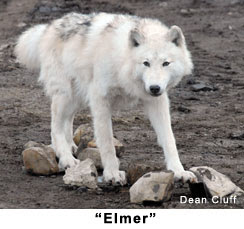 DAY 15
DAY 15DEAN: The recent waiting around for wolves to come to the vicinity of our base camp near the weather station has finally paid off! For a few days now, we have set up a wolf mount, affectionately called “Elmer,” to help us better understand wolf behavior. The mount is particularly suited for conservation/education purposes. Elmer is no ordinary wolf mount in that its legs are removable, and the tail has a wire that allows for different positions. The removable legs are simply to make the mount more portable, and I use an old golf club bag that everything fits into. The mount is very realistic looking, thanks to a great job done by the taxidermist in Yellowknife, Northwest Territories, Canada. Dave and I wanted to set up the mount in advance of wolves coming through the area so that we could observe their response. This is a great opportunity to document aspects of wolf social behavior.
I have heard diverse opinions about what the wolves might do when they encounter “Elmer. “ On two occasions during the past 10 days, we have had wolves approach the mount, and we have noted similarities in their reactions and differences as well. Of course, we need more encounters to note patterns, but the initial sniffing around exhibited by the various wolves has been interesting. Hopefully, the breeding male makes his appearance tonight before we have to leave Eureka. I have video-taped each encounter. For now, I will leave you to speculate on some of the outcomes. Meanwhile, I will get some frame captures from the video for posting.
The wire that makes the tail position on the mount adjustable is an important feature because tail posture and body attitude are visual signals that reveal the rank relationship among pack mates. By being able to interpret these signals, wolves convey and confirm their status with the other members of their family. Thus, there is no need for conflict and recurring reminders about who is in charge. The parents, called the breeding pair by wolf biologists, often carry their tails in an elevated position, one of the ways in which they signal their rank as “heads of the family.” Their offspring of various ages within the pack signal their recognition of the parents’ dominant roles by carrying their tails in a lower position. Older siblings may exhibit dominant body positions or higher tail carriage with their younger brothers and sisters. Submission is signaled by a tucked tail and a lowered body position.
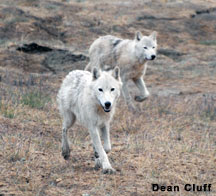 DAVE: Even though we both believe we have located the den, we agree it is too far away from our hilltop vantage point. We would not be able to see the pups from our lookout, and we can’t get any closer than 2 miles because of the mud flats. Thus, our big focus is on using the mount we call Elmer. We waited for the wolves to approach our base camp from mid-afternoon to midnight on Monday, Tuesday and Wednesday to no avail. Then last night, 30 minutes before packing up and calling it quits, we spied a couple of white backs about half a mile away coming our direction. Then another, and another, and another, and finally – EIGHT wolves! We got great video of them inspecting Elmer.
DAVE: Even though we both believe we have located the den, we agree it is too far away from our hilltop vantage point. We would not be able to see the pups from our lookout, and we can’t get any closer than 2 miles because of the mud flats. Thus, our big focus is on using the mount we call Elmer. We waited for the wolves to approach our base camp from mid-afternoon to midnight on Monday, Tuesday and Wednesday to no avail. Then last night, 30 minutes before packing up and calling it quits, we spied a couple of white backs about half a mile away coming our direction. Then another, and another, and another, and finally – EIGHT wolves! We got great video of them inspecting Elmer. After the wolves left Elmer, we followed them from 12:18 a.m. as they headed west along the fiord. Found them chasing leverets (young arctic hares). It was hard to keep track of 8 wolves and several leverets, so not sure the wolves caught any. They headed 1/8 miles up Station Creek and then west up the hill paralleling the fiord and then down to the fiord. They were not afraid of Dean and me, and several of them grouped around us. We then accompanied the pack, some ahead of us, several behind, as we tried to keep up with the leader. I kept trying to figure out the gender of the leader, which was scratching regularly at scent-posts. Finally, I realized it was the breeding female.
After the wolves left Elmer, we followed them from 12:18 a.m. as they headed west along the fiord. Found them chasing leverets (young arctic hares). It was hard to keep track of 8 wolves and several leverets, so not sure the wolves caught any. They headed 1/8 miles up Station Creek and then west up the hill paralleling the fiord and then down to the fiord. They were not afraid of Dean and me, and several of them grouped around us. We then accompanied the pack, some ahead of us, several behind, as we tried to keep up with the leader. I kept trying to figure out the gender of the leader, which was scratching regularly at scent-posts. Finally, I realized it was the breeding female.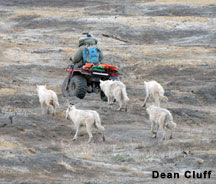 She would do a slight raised-leg urination (see photo), which from a distance looked like a squat defecation, and then she would scratch vigorously. No breeding male to mark with her – he must have gone off on his own earlier. This was a rare occasion to watch the pack while led by the female. We think this is the same female we saw earlier, but no way to prove that. A leveret suddenly jumped up, and all 8 wolves took after it. It gave them a terrific run for their money, but in the end it succumbed to one of the wolves. Two others then gathered around the animal with the young hare, and the breeding female ended up with it and ate it.
She would do a slight raised-leg urination (see photo), which from a distance looked like a squat defecation, and then she would scratch vigorously. No breeding male to mark with her – he must have gone off on his own earlier. This was a rare occasion to watch the pack while led by the female. We think this is the same female we saw earlier, but no way to prove that. A leveret suddenly jumped up, and all 8 wolves took after it. It gave them a terrific run for their money, but in the end it succumbed to one of the wolves. Two others then gathered around the animal with the young hare, and the breeding female ended up with it and ate it.  The wolves returned to the place where Elmer had been and several times carefully examined the spot where he had stood. Then off they headed to the east at 2:58 a.m., and we headed to camp for dinner and to crash.
The wolves returned to the place where Elmer had been and several times carefully examined the spot where he had stood. Then off they headed to the east at 2:58 a.m., and we headed to camp for dinner and to crash. Stiff-legged scratching sometimes follows urination and defecation scent-marking by the breeding pair. This scratching may spread additional scent from the numerous eccrine sweat glands in the footpads. Also, the obvious scratch marks may be visual cues that call attention to the urine or fecal scent marks.

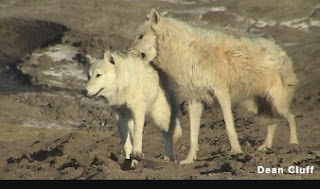
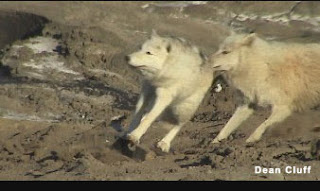
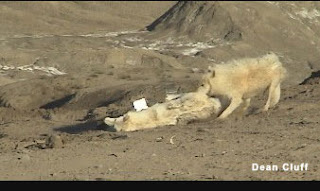
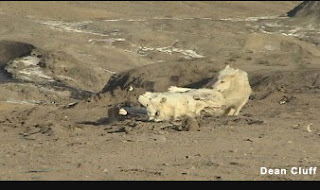
DAY 15 (CONTINUED)
Thursday, July 17, 2008
DEAN: Here are some video frames I took on the first day we decided to conduct some behavioral observations using Elmer. In this sequence, one subordinate wolf (we think is a male) comes in to the area near our base camp where we have set Elmer up. In this encounter, the wolf eventually bites Elmer on the back and pulls him down, then drags him before I intervene. I had to save Elmer’s hide, so to speak!
Note the tucked tail of the wolf as he sniffs the air and approaches Elmer. It is impossible to know what prompts this wolf’s reaction to Elmer, but it’s tempting to conclude that he is trying to drive the trespasser away. Wolves are territorial, and they vigorously defend their territories against encroachment from interlopers. Perhaps the subordinate wolf thinks Elmer is a stranger that has ventured into his family’s domain. Clearly, he is depending on his nose to identify Elmer as either a pack member or an intruder, but since Elmer is a taxidermist mount, it’s hard to know what wolf-like scent, if any, he has retained!
DEAN: Here are the video frames from Elmer’s encounters with various individuals of the eight-member wolf pack that came in last night. There appear to be 5 yearlings (based on their size and behavior) which is consistent with the number of pups observed last year after Dave and I left Eureka without seeing any wolves. The ragged-tailed wolf is the breeding female, and she led the rest of the pack in last night. We are headed out for what we hope will be another evening of “ Encounters with Elmer.”
Yearlings are as tall and as long as adults, but like human adolescents, they have not put on the weight, bulk and stature of their parents and older siblings. They sometimes have what observers call a “bad-hair day.” That is, they may have long hair on the tops of their shoulders that drifts in a halo of tangles as they move about or stand in the wind. Like human teenagers, they may act confident one minute and clueless the next!

Hi-I luved the blog. The Elmer thing was funny.-A couple questions-about how many wolf packs are there on Ellesmere Island? How big are they? Do the wolves there get in conflicts over territory frequently?
ReplyDelete-Mia Werger
Hi, Mia!
ReplyDeleteMy apologies for taking so long to respond. I hope you are still checking the Blog. It is impossible to know exactly how many wolf packs live on Ellesmere. It is huge (as big as the state of Minnesota!), and much of it is locked in ice and snow year round. There are, however, as the Blog say, thermal oases on Ellesmere where there is enough moisture to nurture the minature vegetation that musk oxen depend on. And the wolves depend on the musk oxen and the arctic hares to survive. The territories are huge, naturally, because prey is not abundant. When the musk oxen crash due to starvation in some years, the wolves do, too. There is not, to my knowledge, the territorial strife that may occur elsewhere among wolf packs. In Yellowstone National Park, for instance, wolf packs compete from time to time in the northern range of the park especial - because the territories tend to be small due to the superabundance of prey (elk). Post another comment if you have more questions, and I will be glad to respond.